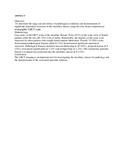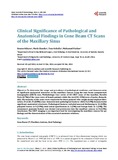| dc.contributor.author | Kihara, E | |
| dc.contributor.author | Chindia, M | |
| dc.contributor.author | Ocholla, T | |
| dc.contributor.author | Parker, M | |
| dc.date.accessioned | 2014-07-16T10:18:04Z | |
| dc.date.available | 2014-07-16T10:18:04Z | |
| dc.date.issued | 2014 | |
| dc.identifier.citation | Kihara, E. , Chindia, M. , Ocholla, T. and Parker, M. (2014) Clinical Significance of Pathological and Anatomical Findings in Cone Beam CT Scans of the Maxillary Sinus. Open Journal of Stomatology, 4, 285-290. doi: 10.4236/ojst.2014.46040. | en_US |
| dc.identifier.uri | http://hdl.handle.net/11295/73116 | |
| dc.description.abstract | Objective: To determine the range and prevalence of pathological conditions and demonstration of significant anatomical structures in the maxillary sinuses using the cone beam computerized tomographic (CBCT) scan. Methodology: Case series of 60 CBCT scans of the maxillae. Results: Forty (67%) of the scans were of female patients while the rest (20, 33%) were of males. Remarkably, the majority of the scans were requested for those patients who sought dental implant fabrication. Overall, 35 (58%) scans demonstrated pathological features while 8 (13%) demonstrated significant anatomical structures. Pathological features included mucosal thickening in 26 (43%), polypoid lesions in 9 (15%), total antral opacification in 1 (2%) and foreign body in 1 (2%). The commonest anatomic feature was dental root protrusion into the maxillary sinuses in 8 (13%). Conclusion: The CBCT imaging is an important tool for investigating the maxillary sinuses for pathology and the demonstration of the associated anatomic relations. | en_US |
| dc.language.iso | en | en_US |
| dc.publisher | University of Nairobi | en_US |
| dc.subject | Cone Beam CT, Maxillary Antrum, Oral Pathology | en_US |
| dc.title | Clinical Significance of Pathological and Anatomical Findings in Cone Beam CT Scans of the Maxillary Sinus | en_US |
| dc.type | Article | en_US |
| dc.type.material | en_US | en_US |


